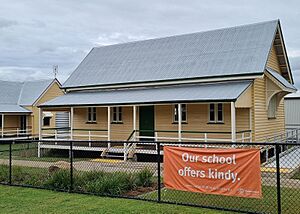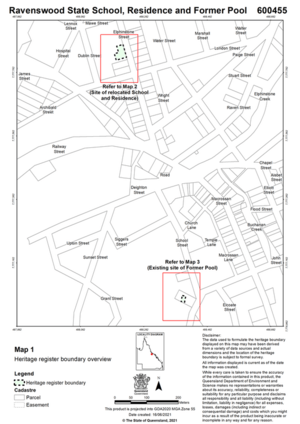Ravenswood School and Residence facts for kids
Quick facts for kids Ravenswood School and Residence |
|
|---|---|

Ravenswood School on new site in Elphinstone Street, 2022
|
|
| Location | School Street, Ravenswood, Charters Towers Region, Queensland, Australia |
| Design period | 1870s–1890s (late 19th century) |
| Built | 1873–1897 |
| Architectural style(s) | Classicism |
| Official name: Ravenswood School and Residence | |
| Type | state heritage (built) |
| Designated | 21 October 1992 |
| Reference no. | 600455 |
| Significant period | 1870s–1890s (historical) 1870s–1890s (fabric) |
| Significant components | school/school room, residential accommodation – headmaster's house |
| Lua error in Module:Location_map at line 420: attempt to index field 'wikibase' (a nil value). | |
The Ravenswood School and Residence is a special old school and house. It is considered a 'heritage-listed' site in Queensland, Australia. This means it is an important historical place! The buildings were first built between 1873 and 1897. They used to be on School Street in Ravenswood, but around 2019, they were moved to a new spot on Elphinstone Street. These buildings were officially added to the Queensland Heritage Register on October 21, 1992.
Contents
A Look at Ravenswood School's Past
The school and the house have been part of the Ravenswood community since 1873. The main school building today is actually an extension from the 1880s. It was added to the original school built in 1873. The house, which was for the head teacher, also dates back to 1873. It was made bigger over the years to fit the needs of the families living there.
Gold Rush and School Beginnings
Gold was found in Ravenswood in 1868. This happened a few years after people started settling in the area for farming. A small town quickly grew, and it was officially named in 1871. Many miners left when they found it hard to get gold from deeper rocks. However, Ravenswood still grew, and more families moved in. Soon, everyone realized a school was needed for the children.
Education in Early Queensland
When Queensland became a separate colony from New South Wales in 1859, it had only two government schools. In 1860, a new law was passed to create a system of State schools. A group called the Board of General Education helped build schools and provide teachers. Queensland was the first colony to offer free primary education starting in 1870. Later, in 1876, a new law created the Department of Public Instruction. This department was in charge of all State primary schools.
Building the First School
In 1872, a group of people in Ravenswood formed a school committee. They started looking for builders to construct a school. The government would provide a teacher and books. However, communities with more than 30 possible students had to pay one-third of the building costs. The committee raised a good amount of money. While waiting for the school to be built, classes were held in an old hotel.
After some disagreements about the building plans, the school and house were finally built in 1873. They opened in January 1874. The school had two classrooms and 70 students. Because it was built before the Queensland State Education Act, it was known as the National School of Ravenswood.
School Land and Growth
The school first sat on a piece of government land. In 1875, the local board asked for more land. They thought the town would keep growing and might need a girls' school later. Over the next 40 years, the school's land size changed. This reflected the good times and tough times Ravenswood went through.
Ravenswood got a boost in the mid-1880s when the Great Northern railway arrived in 1884. New ways to get gold from the ore also helped. New public buildings like a police station, courthouse, post office, and hospital were built. In 1889, the school had its highest number of students, almost 400 children! It was made bigger and by 1905, it had 8 classrooms and a gym.
Decline and Relocation
Ravenswood had a boom between 1900 and 1908. But the cost of getting gold became too high. After World War I, it was clear the gold mining would not recover. In the 1920s, many buildings and people moved away from Ravenswood. By 1929, the school's student numbers dropped below 100. In 1930, Ravenswood became the first town in Queensland to lose its train connection.
As the town's population shrank, parts of the school that were added were removed. However, you can still see where the foundations of these extensions were. Today, the school is growing again. It has a new classroom building and other modern facilities.
The Oldest House in Town
The school residence (the teacher's house) is the oldest building in Ravenswood. It is thought to be the oldest house still standing in any town in North Queensland. Because it is so old, its design is different from many houses built later in Queensland. For example, it used an exposed timber frame, which became popular later. We know a lot about how the house was extended over the years. It looks almost the same today as it did after its last extension in 1897. It shows many building techniques used between 1873 and 1897.
The house was first built as a low timber house with four rooms. It had a fireplace for cooking inside. The outside walls were made of weatherboards, but the inside walls were not covered. There was no separate kitchen. The house only had a front verandah at first. After a complaint, a back verandah was added in 1874.
In 1877, a teacher with a big family moved in. He asked for a separate kitchen because "this climate does not admit of cooking being done in the midst of sleeping apartments." An old building was moved and attached to the house to become the kitchen. Later, part of the back verandah was closed off to make a room for a servant.
In 1883, the main part of the house got ceilings. Repairs were made after storms in 1880 and 1884. The brick chimney was taken down after a bad storm in 1884 and not rebuilt. Big changes happened in 1887. The old kitchen was replaced with a new one, and the back verandah room was moved. A window was added to a bedroom wall. The main walls inside were covered with tongue-and-groove boards. Local builders, Hans Thomsen and John Thomas, did this work.
In 1889, the head teacher asked for "more suitable and worthy accommodation." This shows that public buildings in Ravenswood were being improved. The school also had its highest number of students that year. The department added an extension to the front of the house. They took down the front verandah and built a large living room with verandahs on the front and one side.
The last extension was made in 1897. One whole side of the house was made eight feet wider. This included adding a verandah on the third side of the living room. The verandahs also got ceilings then. Since 1897, the house has only had small changes to its inside walls. It continued to be used as a teacher's home.
In 2019, gold mining in the area expanded. This meant the school and its historic buildings had to be moved. They were relocated to a new site at 30-40 Elphinstone Street.
What the School and Residence Look Like
The Ravenswood School and Residence are located on Elphinstone Street. They are in a good spot overlooking the town. Ravenswood is a mining area with old ruins and piles of dirt from mining. You can also see special chinkee apple trees and rubber vines around.
The School Building
The school is a single-story, rectangular building. It faces the street. It has a timber frame covered with weatherboards. It is raised high on concrete stumps, which creates a shaded area underneath. The roof is steeply sloped and covered with corrugated iron. It extends to a verandah at the front and an enclosed verandah at the back. The verandahs are supported by timber posts and have timber railings.
The Residence Building
The residence is a single-story, rectangular house. It also faces the street. It has a timber frame, sits on low stumps, and is covered with weatherboards. Its shape is unusual because it was extended many times. It has open verandahs with horizontal railings on two sides. The roof is steeply sloped and has many gables. It is covered with corrugated iron.
Why They Are Heritage Listed
The Ravenswood School and Residence were added to the Queensland Heritage Register on October 21, 1992. They met several important requirements:
- Showing Queensland's History: The school buildings show how education developed in remote areas. They also show how important mining towns like Ravenswood were to Queensland's economy. The way the school grew and then shrank shows the changes in Ravenswood's population and its history as a goldfield.
- Unique Cultural Heritage: The Ravenswood School residence, built in 1873, is very important. It is the oldest known house in a North Queensland town. Its design and roof shape are older than the standard house designs that came later. It is also the only one of the first government buildings in the goldfield that is still standing.
- Learning About History: Because they are so old and their changes are well-documented, these buildings can teach us a lot. They can show us early building techniques. They also show how houses were extended to meet changing needs in the 1800s and 1900s.
- Good Examples of Cultural Places: The Ravenswood school is a great example of a school from its time. It has been used continuously for a very long time. The residence is an excellent example of how basic houses in Queensland were made bigger over time.
- Strong Community Connection: The school is important because it has provided public education for many generations of people in Ravenswood. It has a strong connection with the local community.



